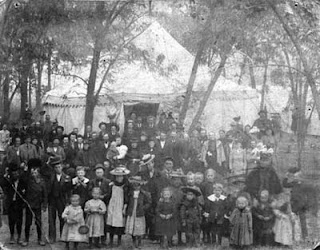“Siberian Seven” lived in our Embassy for 5 years. Pyotr Vashchenko is at upper right.
Pyotr builds a Time Machine. When we arrived in Moscow in the fall of 1981, it was a season of Soviet citizens breaking into our embassy and seeking asylum. Every few days some poor soul would drive past the Soviet Militsiya and try to break in. Our consular people would spend some time talking to them, and then lead them away, where the KGB would quickly take hold of them. Of course, we felt badly about their fate, but we simply could not handle them. We couldn’t simply launch a rocket from the embassy compound and send them to the USA.
We already had a group of seven staying in the embassy. They were Pentacostals from way out in Siberia , and they had broken in one time back in 1978, and sought religious asylum. This was before we arrived, but they were still living in a small apartment in the basement of the embassy.
The embassy wasn’t that big that we could accommodate these people easily. There they were—we couldn’t fly them out, and we did not want to turn them over to the KGB. They were really simple peasants—fiercely religious, but very ignorant of anything beyond their native Chernigorsk.
They were simple, but they learned, as they whiled their years away inside our small Embassy compound. Our daughter Susan came back from college and got a job with the American Consulate, which was in charge of managing our uninvited guests. As a junior official, Susan was assigned to visit the Pentacostals regularly, to find out if they had requirements, and then she would go to the Diplomatic Gastronome a mile away from our Embassy to shop for them.
Although they had known nothing but the poor selection of goods available to Soviet citizens, they quickly learned to demand panty-hose—“Don’t forget—L’Eggs, beige!” Regular Soviet women didn’t even know these products existed. They’d also demand Duncan Hines Cake Mix, where regular Soviets would have had to make do with non-descript boxes marked Flour” in Russian.
Billy Graham visited Moscow USSR Israel and then they went to the U.S.
When Jimmy Carter was President he talked with them by telephone, and then after his term was over he would call them periodically to see how they were doing. The consular girls would tell them they had a call from President Carter, and they would say, “Tell him we’ll call him later!”
These seven Russians had become a royal pain.
The oldest Pentecostal, Pyotr, had been building a “time machine” which he planned to use to get out of our Embassy, and so when the Soviets agreed to let these people emigrate, he demanded that we ship his time machine with him. We had to figure out what to do about this large contraption. The U.S. Government ended up shipping it with him to Israel
Here are some listings of books and papers that may interest you…..
Nazi Death Camps: Biografia Bylych Wiezniow Politycznych Niemieckich Obozow Koncentracyjnych [Translated: Biography of Former Political Prisoners in the German Concentration Camp System] Tom I [Vol. I] Text in Polish. By Komitet Wykonawczy Gladysz, Dr. Inz. Antoni; Szymerski, Andrzej 1974 Philadelphia , PA Oswiecim
Radford's Portfolio of Details of Building Construction; 185 full-page detail drawings by Radford, William A,; Johnson, Bernard L., B.S.; Rawson, Charles P. 1911 Chicago, IL: The Radford Architectural Company. "Remarkable and Unique Collection" of plates showing details of modern building construction and finish for brick, frame, brick-vener, stucco and concrete houses and barns. Details for interior trim including built-in features, kitchen cabinets, cases and cupboards and more. Designs for porches, balconies, stairways, fire places and more. Includes design for a Tuberculosis Camp Tent, Septic Tanks, how to remodel a store into a small theatre, stave silo, cooling box for cream, cold storage, more. 200 pp. 23 x 31 cm. Decorated light tan cloth on board, bottom nine cm of spine torn, edges frayed, inner hinges cracked, detail pencil design drawings in two places. Inscription on front free endpaper: "Wallace A. Jones, 115 Chapman St. , Greenfield , Mass.
Scientific American; The advocate of Industry, and Journal of Scientific, mechanical and other improvements, September 28, 1850, Vol. 6 No. 2 New York , NY
Illustration from Scientific American, Oct. 5, 1850
Scientific American; The advocate of Industry, and Journal of Scientific, mechanical and other improvements, October 5, 1850, Vol. 6 No. 3 1850 New York , NY Pennsylvania
Scientific American; The advocate of Industry, and Journal of Scientific, mechanical and other improvements, October 26, 1850, Vol. 6 No. 6 New York, NY: Munn & Co. McKinney's improved mode of regulating the setting of bows in wagon tops-- used for covered wagons that carried America west. Railroad News: Lawsuit against Baltimore & Ohio RR for refusing to transport live hogs. Monster steamer, 400 feet long, has been contracted for at Cincinnati
Scientific American; The advocate of Industry, and Journal of Scientific, mechanical and other improvements, December 21, 1850, Vol. 6 No. 14 New York, NY: Munn & Co. 8 pp. 28 x 39 cm. Newman's patent Excavating Machinery; German sausages can kill you; Editorial on filthy streets in NYC: city railroads needed. Tehuantepec survey for railroad. Paper periodical, very good. (4319) $15.00. Educational/Scientific
Universal Yankee Nation, The Largest Newspaper in all Creation, Boston, Saturday, May 8, 1841 Purdy, Edward C.; Houghton, John S., Editors. 1841 Boston , MA School Street , Boston Fayetteville , Arkansas and another in Richmond , Virginia St. Louis Boston Europe . The Steamer President not arrived--great excitement in consequence. Settlement of the Chinese question, price of tea drops. Queen Victoria continues in excellent health; she is seen daily taking the air in a pony Phaeton, in the slopes and grounds at Windsor Castle Prince Albert presented a gold chronometer to the captain of the Albert and Wilberforce steamers on their departure with the expedition to the Niger
Contact me at scoulbourn1@verizon.net




















